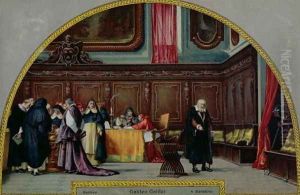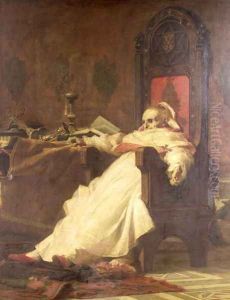Nicholo Barabino Paintings
Nicolò Barabino was an Italian painter, born on October 15, 1832, in Genoa, Italy. He was a significant figure in the Italian art scene during the 19th century, particularly known for his frescoes and historical paintings. Barabino was a dedicated student of art from an early age, studying at the Academy of Fine Arts in Genoa where he honed his skills in painting. His talent was recognized early on, and he received various scholarships that allowed him to further his studies.
In the 1850s, Barabino traveled to Rome, which was a hub for artists at the time. There, he was deeply influenced by the works of Renaissance masters and began to develop his own style, which blended traditional techniques with a sensitivity to the human form and narrative storytelling through art. Upon his return to Genoa, he embarked on a series of important commissions that would establish his reputation.
Barabino's works often depicted religious themes and were characterized by their grandeur and the vividness of their characters. One of his most famous works is the decoration of the ceiling of the Church of The Gesù in Genoa, with the fresco of the 'Triumph of the Name of Jesus', completed in 1874. He was also known for his historical paintings, which were praised for their dramatic intensity and attention to detail.
Throughout his career, Barabino was revered not only for his artistic talents but also for his teaching. He took on numerous pupils and was an influential figure among the next generation of Italian artists. His commitment to the academic approach to art and his emphasis on the importance of historical and religious subjects remained a hallmark of his teaching philosophy.
Nicolò Barabino's contributions to Italian art were widely acknowledged during his lifetime. He received numerous awards and was appointed as a professor at the Academy of Fine Arts in Genoa. His work continued to be celebrated for its emotional depth and technical mastery. Barabino passed away on December 13, 1891, in Genoa, leaving behind a legacy that would continue to inspire Italian artists and art connoisseurs for years to come.

